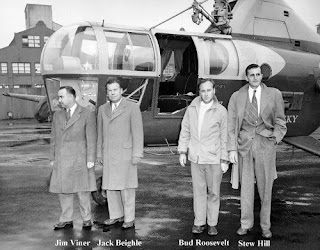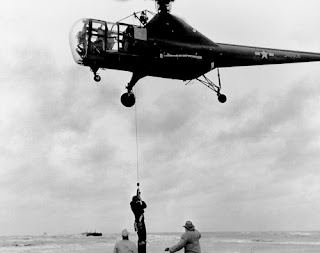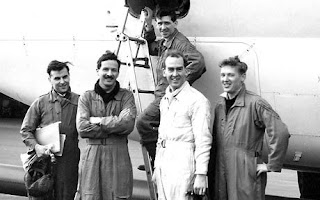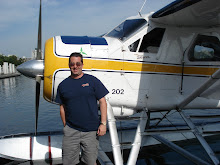Monday, December 29, 2008
Tuesday, December 23, 2008
Alan Smith 1933-

Alan Smith was an ATC Cadet in 1950, joining the RAF thereafter, he flew Meteor NFX1's with 68 Sqn in Germany. He was employed by BAC as a Training Captain (Latterly Chief Training Captain), and flew on quite a few test flights as co-pilot on the BAC 1-11.
In so far as Concorde was concerned, it was unfortunate for the training captains that although they got to fly on some test flights, and also received training towards their pilot-in-command licences, there was not enough flight time available for them to complete a course.As British Airways was the only British operator, the first two airline courses were trained by some of the test pilots.(This was particularly hard on Alan Smith and Paddy Cormican who did a tremendous job in writing the simulator and flight programmes, but did not have the satisfaction of qualifying as Pilot-in-command, and taking part in the flying training).
In all he has flown 75 types/Mks of aircraft including DC-3,Concorde,BAC 1-11
Sunday, December 21, 2008
Dimitry D. (Jimmy) Viner 1908-1998

 Jimmy Viner was born in
Jimmy Viner was born in He joined the original Sikorsky Aero Engineering Corporation at Roosevelt, L. I. in 1923, when the company was founded by his uncle, Igor I. Sikorsky. He was Sikorsky's 15th and youngest employee. He started as an errand boy, stock chaser, sweeper and truck driver. When he requested a title, his uncle designated him "Sikorsky's Director of Transportation". He moved to
Jimmy had acquired more than 1,500 hours of fixed-wing aircraft time and more than 4,000 hours of rotary wing flying. He flew almost eight hours in the VS-300, the first Sikorsky helicopter and he was the first helicopter pilot to log 1,000 hours, in 1947.
Other firsts are: first flights of the S-51, the S-55 and the S-58: first helicopter civilian rescue, in 1945, of two crewmen from an oil barge off Penfield Reef in Fairfield during a storm; first helicopter mail service in New York City; first pilot to operate a helicopter in plane guard work from an aircraft carrier in 1947, this resulted in the first Naval rescue, saving pilots whose planes went into the ocean; set a helicopter world speed record of
The list of pilots and persons who have received helicopter training under Jimmy reads like an aviation "who's Who". He was a two-time recipient of the "Winged-S" Rescue Award of Sikorsky Aircraft, and an honorary member of the American Helicopter Society and a member of the Society of Experimental Test pilots.
Floyd W.Carlson 1917-1984



Floyd Carlson was born in 1917 and died on 9th April 1984.He was a self taught helicopter pilot and the 3rd person in the USA who was granted helicopter rating by the C.A.A. In 1944 he made the first indoor flight in the USA,the second in the world. He was chief pilot and director of flight operations at Bell Helicopter until 1971, when he became special projects engineer.
Jack Zimmerman 1921-2002


Jack Zimmerman was the chief test pilot on the Cessna helicopter during it's life span from 1952 to 1963.
Jack Zimmerman grew up in
Jack became one of the Army's first helicopter pilots. The Army convened its first class at Freeman Field, Indiana to teach experienced pilots how to fly the new helicopter. Jack was sent off to basic helicopter training.
Following training, Jack was assigned to the Aircraft Repair Unit Floating (ARU-F) out of
A typical flight operation could be to deliver a part for B-29s at
After WW2, Jack worked as a helicopter pilot doing commercial work in various locations including
Jack Zimmer.man set many FAI records in the YOH-6A helicopter in 1966 including time-to-climb, distance over a closed course and altitude, several of which are still valid
Saturday, December 20, 2008
Tuesday, December 16, 2008
Phillip 'Spud' Murphy 1926-2011
He resigned his commission in August 1951 in order to join Vickers-Armstrong as an experimental test pilot involved in weapon development on Red Dean and Blue Boar projects flyinf Meteor, Canberra qnd B-29. He became project pilot on the Valiant in flight refuelling and super sprite RATO equipment. Moved to Handley Page in 1958 and was involved in development of Victor BMk1 and 1A Tanker, Spectre RATO,Victor BMk2, Herald and Jetstream Mk1 and Mk2. He ejected from Victor XL159 in March 1962, when the aircraft was locked into a super stall. Appointed Deputy Chief Pilot in 1965 and was awarded the Queens Commendation for Valuable Services in the Air in 1967.
Sunday, December 14, 2008
Malcolm Muir 1929-2008

Malcom Muir(white overalls) with Victor test crew
Malcolm Christison Muir was born at Church Crookham, Hampshire, on
On his release two years later Muir attended
Initially he tested Vampire and Venom fighters at the company’s airfield near
The aircraft had been fitted with an early model of the Martin Baker ejector seat, and one that had no leg restraint system. When Muir ejected at 400mph his legs and arms flailed, causing both knees to be dislocated and a bad fracture of his upper left arm. He also suffered a serious compression fracture of the spine.
After recovering from his injuries, Muir continued testing de Havilland’s fighters and he also delivered Vampires and Venoms to
In May 1958 he was seconded to Rolls-Royce to test the powerful
During his time with Rolls-Royce, when he operated from Hucknall near
After returning to flying, Muir tested the Lightning, the Buccaneer (equipped with the Rolls-Royce Spey engine) and the Victor bomber. But in 1967, with 84 different types of aircraft in his log book, he was forced to retire from flying due to the injuries he had suffered during his ejection and helicopter crash.
Muir spent the next 12 years in Rolls-Royce’s marketing department. He was the sales manager (
Friday, December 12, 2008
Don F. Farquharson OBE 19xx-1997


Donald Frank Farquharson joined the Royal Navy in 1942,trained in the USA and flew Barracudas. After the war he flew the Firefly and in 1947 graduated from the Central Flying School as an instructor.
He converted to helicopters in 1949 and was involved with the introduction of the Dragonfly into the Royal Navy. After loan service with the Royal Australian Navy,during which he was awarded the OBE for rescueoperations in New South Wales flood disaster,he returned to the UK for further service until 1957 when he left the Navy.
He continued his flying career with Westland in 1960. He has over 6,000 flying hours,4200 of them on helicopters. He was project pilot on the Sea King/Commando.
Mike H. Fuller








Mike Fuller started his flying career with the Fleet Air Arm in 1963,specialising in anti-submarine warfare. He qualified as a flying instructor at the Central Flying School and was Captain of the winning team in the 1967 International Search and Rescue competition for the Henry Dunant Trophy. He left the service the same year to join Westland as a test pilot.
He was project pilot for the military and civil versions of the Gazelle, and was involved with the overseas icing trials of the Wessex Mk.5.
Mike was involved with the development of the Lynx from the experimental stages in 1971 to being project pilot (development and aircrew training) for all overseas contracts which included Netherlands,France,Germany,Norway,Brasil,Korea and South Africa.
He was project pilot on the EH101 Merlin for icing trials in Canada and Denmark developing the heated rotor blade system.
He was awarded the R.P. Alston medal for services to test flying by the Royal Aeronautical Society in 1985.
Keith Hill Chadbourn 1933-2018



Keith Chadbourn a former naval aviator, flying mostly Gannets at RNAS Eglinton, Culdrose, and from HMS Ark Royal, he joined Fairey Aviation as a test pilot and flying instructor, Fairey having sold Gannet A/S aircraft to the Indonesian Navy. He spent 2 1/2 years at Surabaja setting up the Indonesian Fleet Air Arm. Returning to UK in 1962, Westland Aircraft having aquired Fairey in the meantime, there was no job. He became an Air Traffic Controller at Heathrow but was delighted to be invited back to White Waltham to head the test flying of Gannet AEW3's being refurbished for a further lease of life with the Fleet.
A move to the west country followed and though continuing with Gannet flying until 1976 he qualified on all the helicopters then and susequently being made by Westland. He finished his active test flying in 1988, but continued as a communications pilot flying the company's Agusta 109 until 1992. From 1954 to 1992, when he retired as Senior Test Pilot, Keith amassed 6,162 hours on 38 types, aeroplanes and helicopters. While at White Waltham the aeroplanes included Swordfish, Fulmar, Stinson Reliant, Auster, Tiger Moth, Dragon Rapide, Dove, Tipsy Nipper, Junior and 'B'. (Peter Twiss was very generous). He flew at Farnborough, Hanover and Paris airshows and at Marignane, in Spain, Qatar, Sweden and Egypt. He was a Member of the Royal Aeronautical Society and a Fellow of the Royal Geographical Society (because of an abiding interest in the Anglo/Zulu war of 1879). He received a Queen's Commendation for Valuable Service in the Air in the 1989 New Year Honours.
Ron R Crayton 1922-2013
 Ron R Crayton
Ron R Crayton
 L to R: Pilots: Mike Ginn, Ron Crayton, FTEs: Mike Ball, Bob Brookes
L to R: Pilots: Mike Ginn, Ron Crayton, FTEs: Mike Ball, Bob Brookes



Lt Cdr R.R.Crayton.R.N was born
In 1945 he was with 734,700 and 762 Sqn. H went to RNAS Worthy Down for a Maintenance Test Pilots Course and then to the Test Flight Section HMS Blackcap.
He performed detachment test flying at RAF Edzell, RAF Kemble and RNAS Dale. After the war he attended RAF Great Rissington Central Flying School Instructors Course in 1947 then to RAF Syerston Instructing. In 1950 he was posted to 767 Sqn HMS Heron where he took DLCO’S and Flight Deck Officers Course.
HMS Vengeance. Bats Officer 15th CAG HMS Indomitable Bats Officer 1st CAG CO MFV. Engine Crank Shaft Explosion, engine room fire. Whilst transporting indomitable personnel. Ordered abandon ship. During 1952 he was with 705 Sqn Instructing and in 1953 was with 705 Sqn. During the Dutch Floods he rescued 80+ people. Then to 848 Sqn RAF
In 1956 he became the Senior Pilot of 845Sqn, the1st Dunking Sonar Sqn. He was called into action during the
After
He resigned his Commission in R.N. to join Westland Helicopters as a Senior Test Pilot. As a test pilot with
He gave Air day demonstrations and flew at the Paris and Farnborough displays. After retirement from flying, he ran the family business until final retirement in 1988.
Eur Ing David Gibbings MBE C Eng, FRAeS 1932-







-->
John W. “Hank” Lankford 1922-1990


John W. “Hank” Lankford was born in 1922 at













